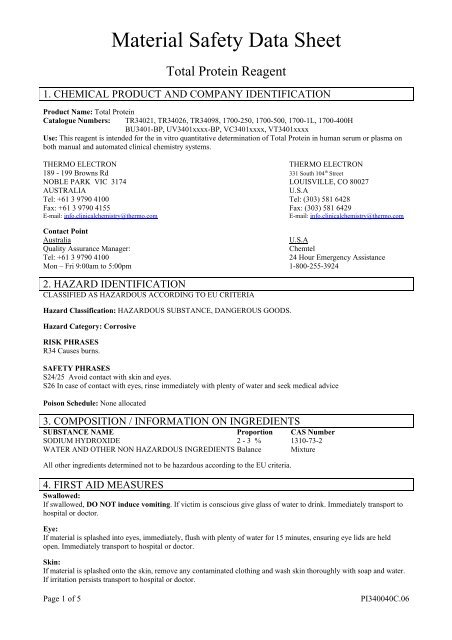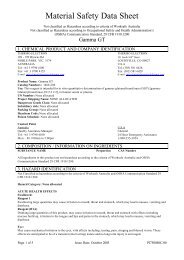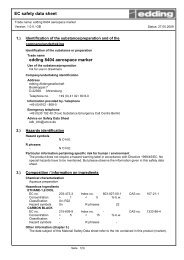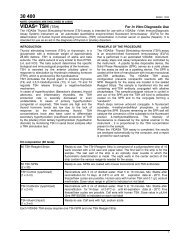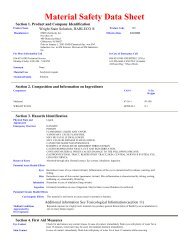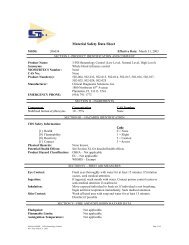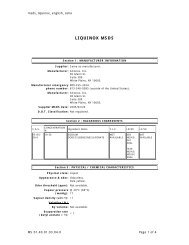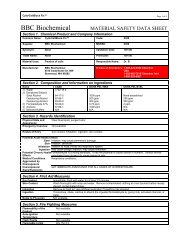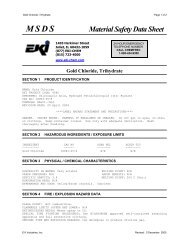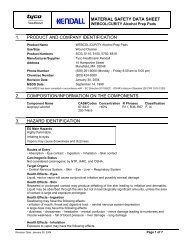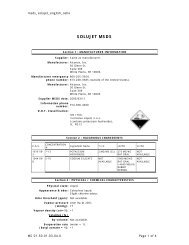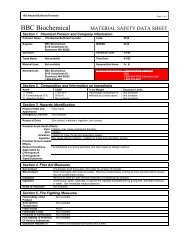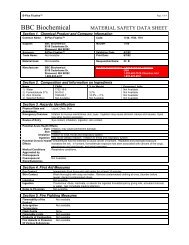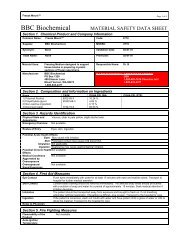Material Safety Data Sheet - Mercedes Medical
Material Safety Data Sheet - Mercedes Medical
Material Safety Data Sheet - Mercedes Medical
You also want an ePaper? Increase the reach of your titles
YUMPU automatically turns print PDFs into web optimized ePapers that Google loves.
<strong>Material</strong> <strong>Safety</strong> <strong>Data</strong> <strong>Sheet</strong><br />
Total Protein Reagent<br />
1. CHEMICAL PRODUCT AND COMPANY IDENTIFICATION<br />
Product Name: Total Protein<br />
Catalogue Numbers: TR34021, TR34026, TR34098, 1700-250, 1700-500, 1700-1L, 1700-400H<br />
BU3401-BP, UV3401xxxx-BP, VC3401xxxx, VT3401xxxx<br />
Use: This reagent is intended for the in vitro quantitative determination of Total Protein in human serum or plasma on<br />
both manual and automated clinical chemistry systems.<br />
THERMO ELECTRON<br />
THERMO ELECTRON<br />
189 - 199 Browns Rd 331 South 104 th Street<br />
NOBLE PARK VIC 3174 LOUISVILLE, CO 80027<br />
AUSTRALIA<br />
U.S.A<br />
Tel: +61 3 9790 4100 Tel: (303) 581 6428<br />
Fax: +61 3 9790 4155 Fax: (303) 581 6429<br />
E-mail: info.clinicalchemistry@thermo.com<br />
E-mail: info.clinicalchemistry@thermo.com<br />
Contact Point<br />
Australia<br />
U.S.A<br />
Quality Assurance Manager:<br />
Chemtel<br />
Tel: +61 3 9790 4100<br />
24 Hour Emergency Assistance<br />
Mon – Fri 9:00am to 5:00pm 1-800-255-3924<br />
2. HAZARD IDENTIFICATION<br />
CLASSIFIED AS HAZARDOUS ACCORDING TO EU CRITERIA<br />
Hazard Classification: HAZARDOUS SUBSTANCE, DANGEROUS GOODS.<br />
Hazard Category: Corrosive<br />
RISK PHRASES<br />
R34 Causes burns.<br />
SAFETY PHRASES<br />
S24/25 Avoid contact with skin and eyes.<br />
S26 In case of contact with eyes, rinse immediately with plenty of water and seek medical advice<br />
Poison Schedule: None allocated<br />
3. COMPOSITION / INFORMATION ON INGREDIENTS<br />
SUBSTANCE NAME Proportion CAS Number<br />
SODIUM HYDROXIDE 2 - 3 % 1310-73-2<br />
WATER AND OTHER NON HAZARDOUS INGREDIENTS Balance Mixture<br />
All other ingredients determined not to be hazardous according to the EU criteria.<br />
4. FIRST AID MEASURES<br />
Swallowed:<br />
If swallowed, DO NOT induce vomiting. If victim is conscious give glass of water to drink. Immediately transport to<br />
hospital or doctor.<br />
Eye:<br />
If material is splashed into eyes, immediately, flush with plenty of water for 15 minutes, ensuring eye lids are held<br />
open. Immediately transport to hospital or doctor.<br />
Skin:<br />
If material is splashed onto the skin, remove any contaminated clothing and wash skin thoroughly with soap and water.<br />
If irritation persists transport to hospital or doctor.<br />
Page 1 of 5<br />
PI340040C.06
<strong>Material</strong> <strong>Safety</strong> <strong>Data</strong> <strong>Sheet</strong><br />
Total Protein Reagent<br />
4. FIRST AID MEASURES (continued)<br />
Inhaled:<br />
Move victim to fresh air. Apply resuscitation if victim is not breathing.<br />
First Aid Facilities:<br />
Eye wash fountain, safety shower and normal wash room facilities.<br />
Advice to Doctor:<br />
Treat symptomatically.<br />
In case of poisoning, contact Poisons Information Centre<br />
In Australia call Tel: 131126<br />
In New Zealand Tel: 034747000<br />
5. FIRE-FIGHTING MEASURES<br />
Fire/Explosion Hazard<br />
If safe to do so, move undamaged containers from fire area.<br />
Hazardous Decomposition Products: Decomposes on heating emitting noxious smoke.<br />
Fire Fighting Procedures: Fire fighters to wear Self-contained breathing apparatus (SCBA) in confined spaces, in<br />
oxygen deficient atmospheres or if exposed to products of decomposition. Full protective clothing is also recommended.<br />
Extinguishing Media: Use extinguishing media suitable for surrounding fire situation.<br />
Flammability<br />
This material is not a flammable or combustible liquid.<br />
6. ACCIDENTAL RELEASE MEASURES<br />
<strong>Material</strong> may be slippery when spilt. Walk cautiously. Ventilate area. Wear protective equipment to prevent skin and<br />
eye contact, as outlined under personal protection in this MSDS. Bund area using sand or soil - to prevent run off into<br />
drains and waterways. Place absorbent (soil, sand, vermiculite or other inert material) onto spill. Collect and seal in<br />
properly labeled containers for disposal. Remainder of material may be neutralized by cautiously adding vinegar.<br />
Collect this material after foaming/effervescence ceases and place into above labeled container.<br />
7. HANDLING AND STORAGE<br />
Store in a cool place and out of direct sunlight. Store away from sources of heat or ignition. Store away from strong<br />
acids. Keep containers closed, when not using the product. Store at 2-25°C and the reagent will be stable until the<br />
expiry date stated on the bottle and kit box labels. Store in original packages as approved by manufacturer.<br />
8. EXPOSURE CONTROLS / PERSONAL PROTECTION<br />
Exposure Standards<br />
No exposure standards are available for this product, however, the following exposure standards have been assigned by<br />
the National Occupational Health & <strong>Safety</strong> Commission (NOHSC) to the following component of the product:<br />
SODIUM HYDROXIDE<br />
(Worksafe Australia)<br />
[TWA] 2 mg/m³<br />
[STEL] Peak limitation<br />
Notices: H<br />
Engineering Controls<br />
Maintain adequate ventilation at all times. In most circumstances natural ventilation systems are adequate unless the<br />
material is heated, reacted or otherwise changed in some type of chemical reaction, then the use of a local exhaust<br />
ventilation system is recommended.<br />
Personal Protection Equipment<br />
GLOVES: Not normally required, however, if product has spilt, or package is broken, then the use of PVC or<br />
neoprene gloves is recommended.<br />
Page 2 of 5<br />
PI340040C.06
<strong>Material</strong> <strong>Safety</strong> <strong>Data</strong> <strong>Sheet</strong><br />
Total Protein Reagent<br />
8. EXPOSURE CONTROLS / PERSONAL PROTECTION (continued)<br />
EYES: Chemical goggles or glasses to protect eyes.<br />
RESPIRATORY PROTECTION: Avoid breathing of vapours. The use of a respirator is not normally required,<br />
however, if entering spaces where the airborne concentration of a contaminant is unknown then the use of a Selfcontained<br />
breathing apparatus (SCBA) with positive pressure air supply complying with AS/NZS 1715 / 1716, or any<br />
other acceptable International Standard is recommended. Select and use respirators in accordance with AS/NZS<br />
1715/1716.<br />
9. PHYSICAL AND CHEMICAL PROPERTIES<br />
Appearance:<br />
Boiling Point:<br />
Freezing Point:<br />
Vapour Pressure:<br />
Specific Gravity:<br />
Flash Point:<br />
Flammability Limits:<br />
Solubility in Water:<br />
Other Properties<br />
pH: 13.5±0.1<br />
% VOLATILES: > 85 %<br />
Clear blue liquid with no odour.<br />
Not available.<br />
Not available.<br />
Not available.<br />
Not available.<br />
Not applicable.<br />
Not applicable.<br />
Completely miscible.<br />
10. STABILITY AND REACTIVITY<br />
STABILITY:<br />
Stable under normal conditions of use.<br />
HAZARDOUS DECOMPOSITION PRODUCTS:<br />
Decomposes on heating emitting noxious smoke.<br />
HAZARDOUS POLYMERIZATION:<br />
Will not occur.<br />
INCOMPATIBILITIES:<br />
Strong mineral acids (sulfuric, nitric and hydrochloric), aluminium, zinc and magnesium.<br />
CONDITIONS TO AVOID:<br />
Incompatibles, especially reaction with zinc, aluminium or magnesium, which may release flammable hydrogen gas<br />
which could be ignited by heat, flames, ignition sources and led to an explosion.<br />
11. TOXICOLOGICAL INFORMATION<br />
There is no toxicological information available for this product, however, for the ingredient:<br />
Sodium hydroxide:<br />
According to OECD Guideline for the Testing of Chemicals (OECD 405) for eye corrosion and<br />
OECD Guideline for the Testing of Chemicals (OECD 404) for skin corrosion, both test procedures have been utilized<br />
to determine that sodium hydroxide is a confirmed corrosive substance.<br />
This product contains 2 - 3 % of sodium hydroxide which is considered to be CORROSIVE according to Worksafe<br />
Australia, we anticipated that this product will cause burns to the eyes and skin.<br />
Hazard Category:<br />
ACUTE HEALTH EFFECTS<br />
Swallowed:<br />
Will cause burns to the mouth, mucous membranes, throat, oesophagus and stomach. If sufficient quantities<br />
(approximately 150 ml) are ingested (swallowed) death may occur.<br />
Page 3 of 5<br />
PI340040C.06
<strong>Material</strong> <strong>Safety</strong> <strong>Data</strong> <strong>Sheet</strong><br />
Total Protein Reagent<br />
11. TOXICOLOGICAL INFORMATION (continued)<br />
Eye:<br />
Will cause burns to the eyes with effects including: Pain, tearing, conjunctivitis, corneal ulcerations and if duration of<br />
exposure is long enough, blindness will occur.<br />
Skin:<br />
Will cause burns to the skin, with effects including; Redness, blistering, localised pain and inflammation.<br />
Inhaled:<br />
Will cause irritation to the nose, throat and respiratory system with effects including: Dizziness, headache, coughing,<br />
loss of co-ordination and chest pains.<br />
Chronic:<br />
Prolonged or repeated skin contact will lead to necrosis (death) of the skin.<br />
12. ECOLOGICAL INFORMATION<br />
No information is available for this product, however, for sodium hydroxide component:<br />
Water pollution:<br />
Persistency: Can persist for extended periods of time.<br />
Effect on water treatment process: Can raise pH and interfere with coagulation.<br />
Avoid contaminating drains, sewers or waterways.<br />
13. DISPOSAL CONSIDERATIONS<br />
Refer to appropriate authority in your State. Normally suitable for disposal by approved waste disposal agent.<br />
14. TRANSPORT INFORMATION<br />
Road and Rail Transport:<br />
Not classified as a Dangerous Good according to the United Nations Recommendations for the Transport of Dangerous<br />
Goods and Globally Harmonized System for the classification and labelling of Chemicals.<br />
Marine Transport:<br />
Not classified as a Dangerous Good according to the International Maritime Organization Rules (Maritime Dangerous<br />
Goods Code - IMDG Code) for transport by sea.<br />
This product is classified as a Dangerous Good according to ICAO/IATA regulations:<br />
PROPER SHIPPING NAME: CORROSIVE LIQUID, BASIC, INORGANIC, N.O.S.(SODIUM HYDROXIDE)<br />
UN No: UN3266<br />
CLASS: 8<br />
PACK GROUP: II<br />
15. REGULATORY INFORMATION<br />
Poison Schedule: None allocated.<br />
Inventory Status:<br />
Australia (AICS)<br />
United States (TSCA)<br />
Canada (DSL)<br />
Europe (EINECS/ELINCS)<br />
Japan (MITI)<br />
South Korea (KECL)<br />
Y<br />
Y<br />
Y<br />
Y<br />
Y<br />
Y<br />
Y = all ingredients are on the inventory.<br />
Page 4 of 5<br />
PI340040C.06
16. OTHER INFORMATION<br />
Issue date: July, 2004<br />
<strong>Material</strong> <strong>Safety</strong> <strong>Data</strong> <strong>Sheet</strong><br />
Total Protein Reagent<br />
Reasons for Update:<br />
1. Alignment with the 2 nd Edition of National Code of Practice for the Preparation of <strong>Material</strong> <strong>Safety</strong> <strong>Data</strong> <strong>Sheet</strong>s<br />
[NOHSC:2001(2003).<br />
2. Changes and /or addition made to all sections.<br />
Key Legend Information:<br />
NOHSC - National Occupational Health & <strong>Safety</strong> Commission [Aust]<br />
TWA - Time Weighted Average [Int]<br />
STEL - Short Term Exposure Limit [Int]<br />
AICS - Australian Inventory of Chemical Substances<br />
EPA - Environmental Protection Agency [Int]<br />
NIOSH - National Institute for Occupational <strong>Safety</strong> and Health [US]<br />
AS/NZS 1715 - Selection, use and maintenance of respiratory protectice devices. [Aust]<br />
AS/NZS 1716 - Respiratory protective devices. [Aust]<br />
IATA - International Aviation Transport Authority [Int]<br />
ICAO - International Civil Aviation Organization<br />
IM IMDG - International Maritime Dangerous Goods<br />
United Nations Recommendations for the Transport of Dangerous Goods and Globally Harmonized System for the<br />
classification and labelling of Chemicals. [Int]<br />
EU - European Union<br />
[Aust/NZ] = Australian/New Zealand<br />
[Int] = International<br />
[US] = United States of America<br />
Principal References:<br />
Information supplied by manufacturer, reference sources including the public domain.<br />
Disclaimer<br />
This MSDS summarises our best knowledge of the health and safety hazard information of the product and how to<br />
safely handle and use the product in the workplace. Each user should read this MSDS and consider the information in<br />
the context of how the product will be handled and used in the workplace including in conjunction with other products.<br />
If clarification or further information is needed to ensure that an appropriate risk assessment can be made, the user<br />
should contact this company.<br />
Our responsibility for products sold is subject to our standard terms and conditions which are available on request.<br />
© 2004 Thermo Electron Corporation. All rights reserved<br />
License granted to make unlimited paper copies for internal use only.<br />
END OF MSDS<br />
Page 5 of 5<br />
PI340040C.06


